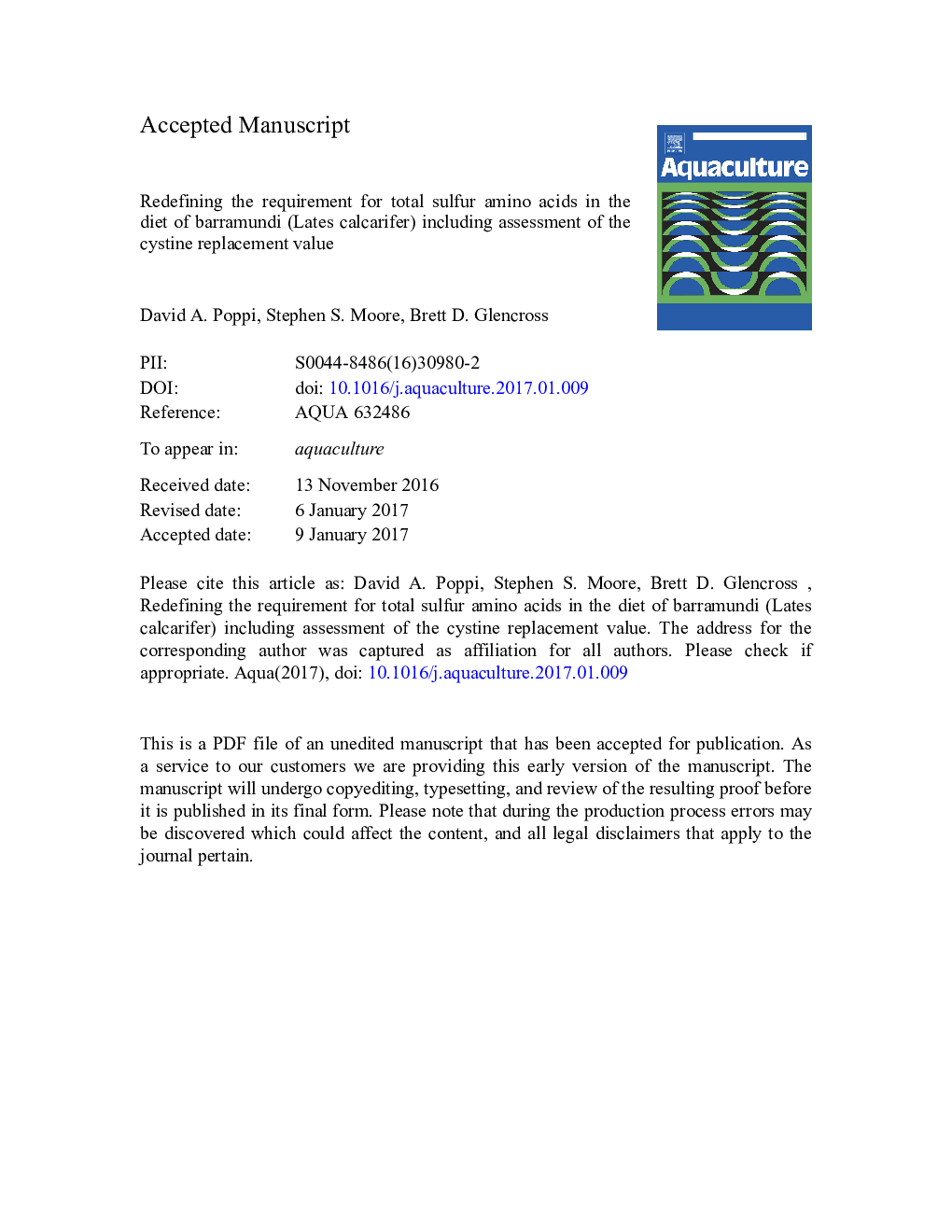| کد مقاله | کد نشریه | سال انتشار | مقاله انگلیسی | نسخه تمام متن |
|---|---|---|---|---|
| 5539555 | 1552817 | 2017 | 35 صفحه PDF | دانلود رایگان |
عنوان انگلیسی مقاله ISI
Redefining the requirement for total sulfur amino acids in the diet of barramundi (Lates calcarifer) including assessment of the cystine replacement value
دانلود مقاله + سفارش ترجمه
دانلود مقاله ISI انگلیسی
رایگان برای ایرانیان
کلمات کلیدی
موضوعات مرتبط
علوم زیستی و بیوفناوری
علوم کشاورزی و بیولوژیک
علوم آبزیان
پیش نمایش صفحه اول مقاله

چکیده انگلیسی
This study was designed to confirm a previous estimate of the methionine (Met) and total sulfur amino acid (TSAA) requirement of juvenile barramundi (Lates calcarifer) (Coloso et al., 1999) with a view for further study. Triplicate groups of fish (initial weight: 18.3 g ± 1.5 g) were fed diets with graded levels of dietary Met (7.2-12.8 g kgâ 1 DM), centred around a previously reported requirement, and a constant dietary cystine (Cys) inclusion (5.9 g kgâ 1 DM) over a 42 day period. At the termination of the experiment, a significant linear increase (p < 0.001) in %BW gain was observed in response to increasing dietary methionine, with no plateau in growth, suggesting the previous estimate of requirement may have been inadequate. A second experiment was designed to re-evaluate the Met/TSAA requirement in which a broader range of methionine inclusion levels were assessed (8.6-21.4 g kgâ 1 diet DM Met). Triplicate groups of fish (initial weight: 36.4 g ± 8.3 g) were fed the diets for a period of 49 days. A plateau and subsequent depression in growth, as well as significant (p < 0.05) effects of dietary Met inclusion on %BW gain, feed conversion ratio (FCR) and protein retention efficiency (PRE) were observed at the conclusion of this experiment. The best fitting of nine nutrient response models, the Compartmental Model (R2 = 0.71), predicted a requirement for Met of between 10.5 (95% of maximum response) and 13.6 g kgâ 1 (99% of maximum response) in a diet with 592 g kgâ 1 CP and 6.6 g kgâ 1 Cys (17.1-20.2 g kgâ 1 TSAA; 1.8-2.3% CP Met + 1.1% CP Cys). This TSAA requirement is equivalent to 43-51% of the lysine content of the diets. The applicability of this mode of expression and its relation to the ideal protein concept is discussed as is the application of different response models to the data. The impact of dietary Met:Cys ratio was also investigated with results suggesting at least 40% of dietary Met can be replaced with Cys without significantly affecting animal performance. It was concluded that disparity in the estimates of Met and TSAA requirement between this study and that of Coloso et al. (1999) was likely the result of a combination of model choice, experimental design and mode of expression of the requirements.
ناشر
Database: Elsevier - ScienceDirect (ساینس دایرکت)
Journal: Aquaculture - Volume 471, 20 March 2017, Pages 213-222
Journal: Aquaculture - Volume 471, 20 March 2017, Pages 213-222
نویسندگان
David A. Poppi, Stephen S. Moore, Brett D. Glencross,